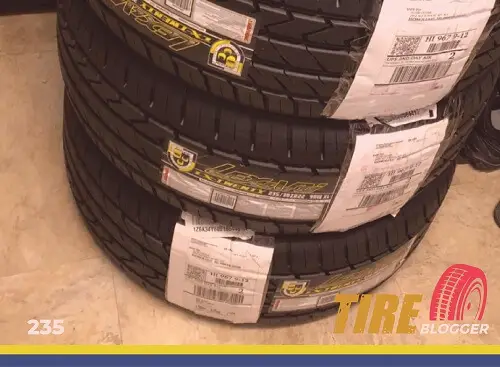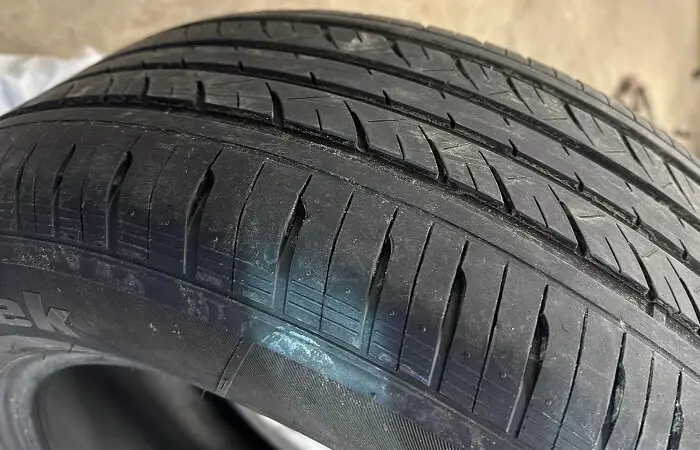225 vs 235 Tires

The numbers 225 and 235 refer to the width of a tire in millimeters when it is mounted and measured from sidewall to sidewall. The section width is the primary difference between 235 and 225 tire sizes. The 235 tire is approximately 10 millimeters wider than the 225 tire.
225 vs 235 Table
This comparison table provides a quick and easy way to understand the differences between the two tire sizes.
| 225 Tire Size | 235 Tire Size |
|---|---|
| More comfortable ride | Maximum traction on dry roads |
| Generally less expensive | Better handling performance |
| Better traction in snow, rain, and slush | Suitable for carrying heavier loads |
| Improved fuel economy | More attractive appearance |
| Recommended rim width range: 6 to 8 inches | Recommended rim width range: 6.5 to 8.5 inches |
| Smaller than 235 tire size by 10 millimeters | Larger than 225 tire size by 10 millimeters |
| Can replace 235 tire size (shared rim width overlap) | Can replace 225 tire size (shared rim width overlap) |
Gas Mileage
The slightly smaller 225 tires offer better gas mileage compared to 235 tires. With a smaller width and diameter, 225 tires present less rolling resistance and rotational mass, allowing for better fuel efficiency.
This makes them ideal for daily commuting and long highway trips where preserving gas mileage is a priority. Though the difference between 225 and 235 tires is slight, the improved efficiency can provide noticeable fuel savings over time.
Ride Comfort
The wider 235 tires offer a more comfortable ride than the 225 tires. Their larger contact patch and sidewall flex absorb bumps and uneven road surfaces better.
However, the difference may be negligible for most driving conditions. Only on particularly rough terrain would the more expansive 235 tires demonstrate appreciably enhanced cushioning over 225 tires.

Aesthetics Look
Visually, 235 tires convey a more aggressive, rugged look, especially on trucks or SUVs, compared to the narrower 225 tires.
However, the slightly smaller 225 tires actually provide benefits in terms of aerodynamic efficiency, leading to improved fuel economy. So, while 235 tires make more of an aesthetic impact, 225 tires offer practical advantages.
Handling & Stability
The 225 tires, with their smaller contact patch provide quicker steering response and enhanced handling on paved roads relative to 235 tires. Their lighter weight also allows for better acceleration and braking performance.
But the wider 235 tires offer better stability and traction in off-road situations thanks to their larger footprint and footprint contact area.
Noise & Vibration
Overall, 225 tires transmit fewer vibrations and reduce interior cabin noise on smooth roads. But on uneven or broken pavement, the more expansive 235 tires can better dampen vibrations before they reach the chassis.
Either way, the difference in noise and vibration levels between these two tire widths is generally unnoticeable during everyday driving.

Durability & Wear
With less mass and a slimmer profile, 225 tires potentially demonstrate more even wear across their tread life. They also place less strain on suspension and driveline components.
The 235 tires are heavier and endure more impacts, leading to more wear on other vehicle parts over time. For longevity, 225 tires present some slight advantages.
Load Capacity
Thanks to their wider build and larger contact patch, 235 tires offer more load-carrying capacity than 225 tires.
This becomes important for hauling heavy cargo or towing, where the additional traction and weight distribution of the 235 tires provide crucial stability and safe loading handling. This can be a determining factor favouring 235 tires for trucks and SUVs.

Adverse Conditions
In snow and ice, narrower 225 tires can cut through to the road below more effectively, enhancing cold-weather traction.
But wider 235 tires perform better over mud, sand, or uneven terrain by distributing the vehicle’s weight over a larger footprint area for better stability and grip.
Can I Use 235 Tires Instead of 225?
It is safe to replace 225 tires with 235 tires if the aspect ratio and rim size remain the same. For instance, if you have 17-inch rims and a 70 aspect ratio, the overall diameter of your tires would be 30.9 inches for 225 tires and 31.2 inches for 235 tires.
This difference is only 1%, which is well within the 3% limit for replacement tires. Ensure the new 235 tires match the existing aspect ratio and rim size specifications.

How Much Wider is a 235 Than a 225 Tire?
The 235 tire is 10 millimeters (approximately 0.4 inches) wider than a 225 tire. The numbers 225 and 235 represent the tire’s width in millimeters.
So the difference in width between the two sizes is simply the numerical difference: 235 – 225 = 10 millimeters.
How Much Taller is a 235 Tire Than a 225?
To determine a tire’s height, we need to consider its width, aspect ratio, and rim size. Assuming both tires have the same aspect ratio and rim size, we can find the height difference based on their widths.
Let’s say both tires have a 50 aspect ratio (meaning the tire height is 50% of its width). In this case, a 225 tire would have a height of around 631.4 millimeters.
On the other hand, a 235 tire would measure about 641.4 millimeters in height. As a result, the 235 tires are roughly 0.39 inches or 10 millimeters taller than the 225 tires.
Our Observation
The minor differences between 225 and 235 tires come down to use case priorities. For improved fuel efficiency and high-speed handling, 225 tires have some advantages.
But the wider 235 tires provide better load capacity, off-road stability, and a bold aesthetic appeal.
For most drivers doing a mix of city and highway driving, the 225 tires strike the best balance of efficiency, ride comfort, and wear durability at a slight benefit over 235 tires. We’d recommend 225 tires for their well-rounded everyday performance.

Meet Caitlin McCormack, a Tire Size Expert and Blogger Passionate About Everything Related to Tires. With Years of Experience in the Tire Industry, Caitlin Has Become an Expert in Tire Sizes and Their Impact on Vehicle Performance.
